As we passed by the unique Harajuku subway building to the start of the walking path down to Meiji Shrine I was struck by the scale of the place. In a city with the population density of Tokyo you would imagine there would be very little public open space let alone a forest in the middle of the city. That the shrine grounds occupy 174 acres sprawling between Shinjuku and Shibuya leaves no doubt that Emperor Meiji and Empress Shoken were very highly regarded by the people of Japan .
As we entered the walkway the serenity was broken momentarily as a shrill whistle pierced the air and a policeman trots past me waving his arms and blowing hard on his whistle in pursuit of a cyclist who had enter the walkway on his bike. The errant cyclist was left in no doubt of the error of his ways as everyone freezes to watch the spectacle.
The forest of 120,000 trees surrounding the shrine isn’t a remnant of bush in the city, it was planted from scratch when the Shrine was built and many of the trees were donated by citizens from all around Japan. As you enter Meiji Shrine you will pass through two of Japans largest Torii gates made of 1700 year old Cyprus wood. The torii gates mark the transition from the outside world to the purity of the shrine and it’s normal to bow before walking through the torii although it’s not expected of foreign visitors. You should walk through within the arch but to either side not directly through the middle which is the path of the gods.

Along the path to the right is a souvenir shop and cafe, we didn’t have anything at the cafe which was heavily frequented with bus tours at the time we went past and there really were too many other delicious options to try in the area anyway.
On the left is the entrance to the Nai-en garden which was a favourite strolling place of Emperor Meiji and Empress Shoken, it’s said it was designed by the Emperor for his wife There’s a large pond with waterlillies and koi swimming in it and if you are there in the middle of the year the iris garden with 150 different types of iris blooms from early June.
Just before passing through the second torii, there are two huge racks filled with barrels of wine and sake. It’s normal to see the racks of colourful sake barrels at major shrines but the French wine from the top wineries in the Bourgogne (Burgundy) region was a gift to be consecrated at the shrine to the spirit of world peace and amity. It is particularly fitting as Emperor Meiji led the way in the modernisation of Japan and himself embraced aspects of western culture in his life including food and wine.
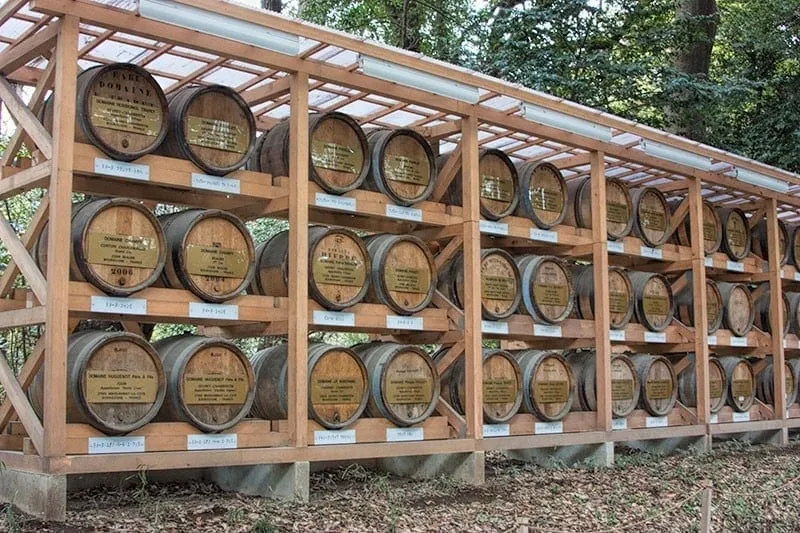
On your left after the torii is the cleansing station or Chozuya, Shrine etiquette is important and before entering a shrine people purify themselves using the ladle to wash first one hand and then the other. Traditionally water is also poured into the hand and then used to rinse the mouth but I have noticed that many people don’t seem to do that part and no one seems to mind, just be sure that you don’t drink directly from the ladle.
From there you pass through the beautiful Kita-mon (north) gate shown below and into the inner shrine grounds.
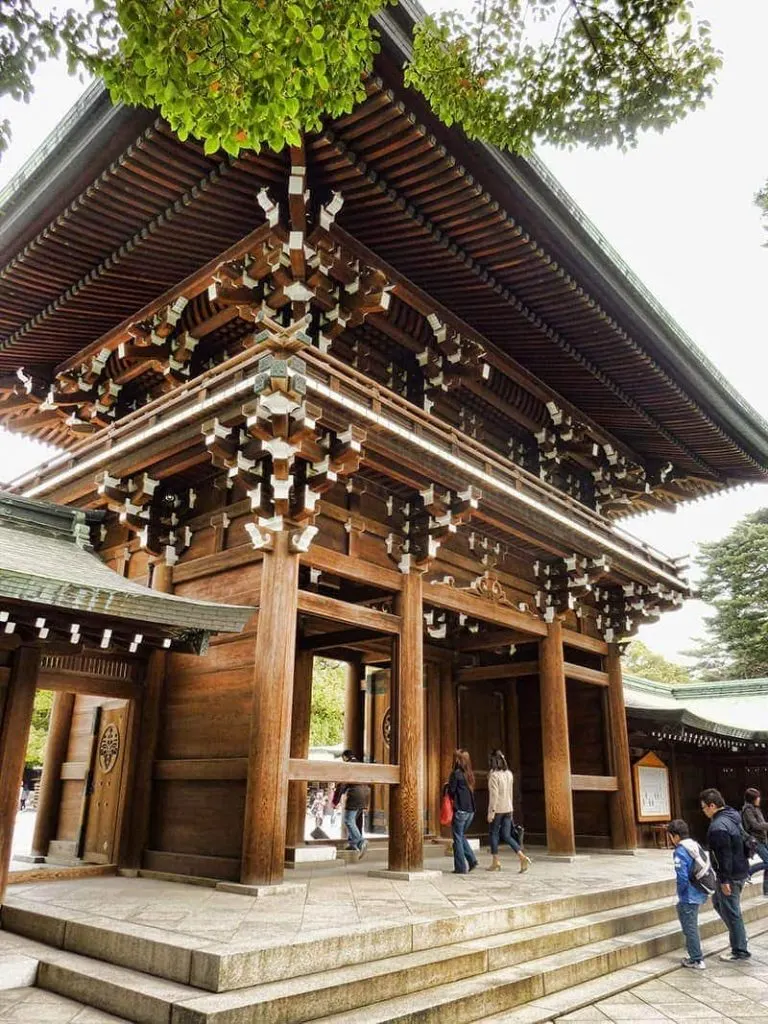

The courtyard is large and once again the scale is striking, directly in front of you is the Honden (main hall) also made of Cyprus wood and cooper roofing but there is so much to see to the left and right that I took a moment to orient myself, then just as I walked inside we saw our first Japanese wedding procession.
Although we’d see many more of these on our travels, at the time we were quite blown away by the drama and became instantly fascinated by the elaborate wedding kimono worn by the bride.
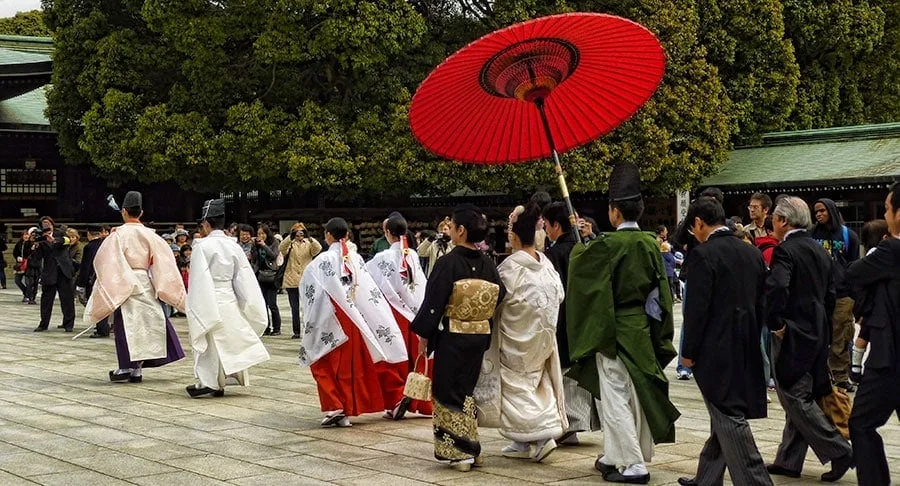
Between weddings we took a look around the rest of the shrine grounds, the photos below show the Honden (main hall) and the sacred Camphor wishing tree with uma hung around it. You’ll see a number of sacred trees around Japan and you’ll recognise them by the heavy ropes tied around them. Surrounding this particular tree is a wishing wall where ema tablets are hung by visitors after writing their prayers on them. Shinto Priests then pray for all of the wishes hung there.
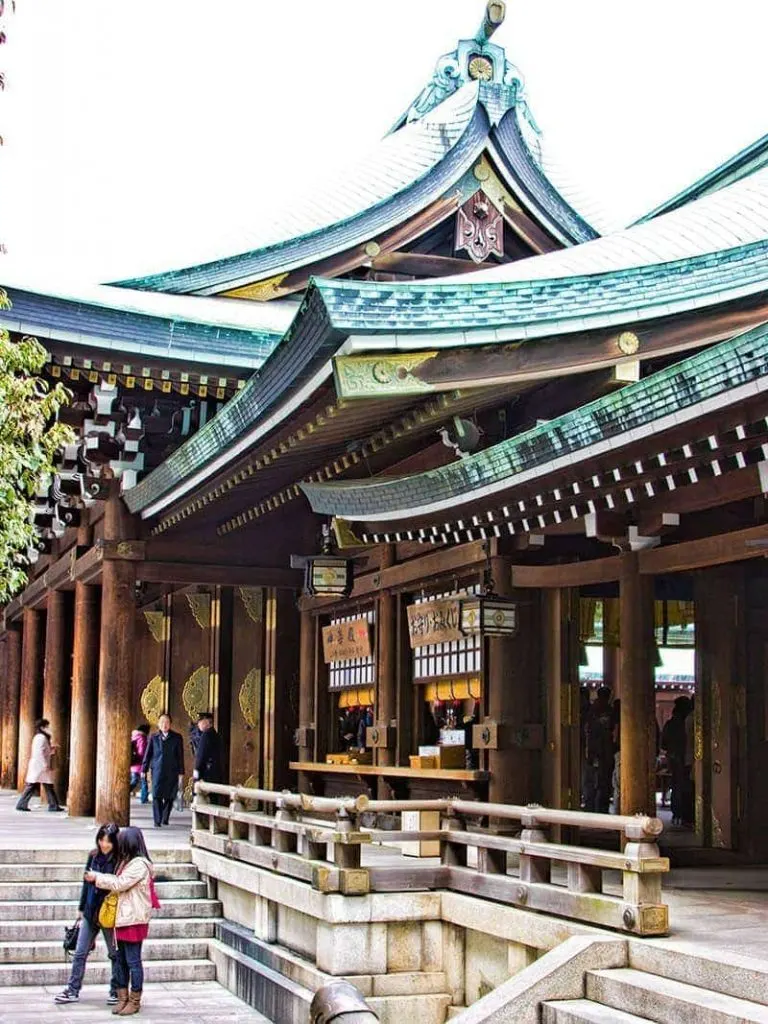
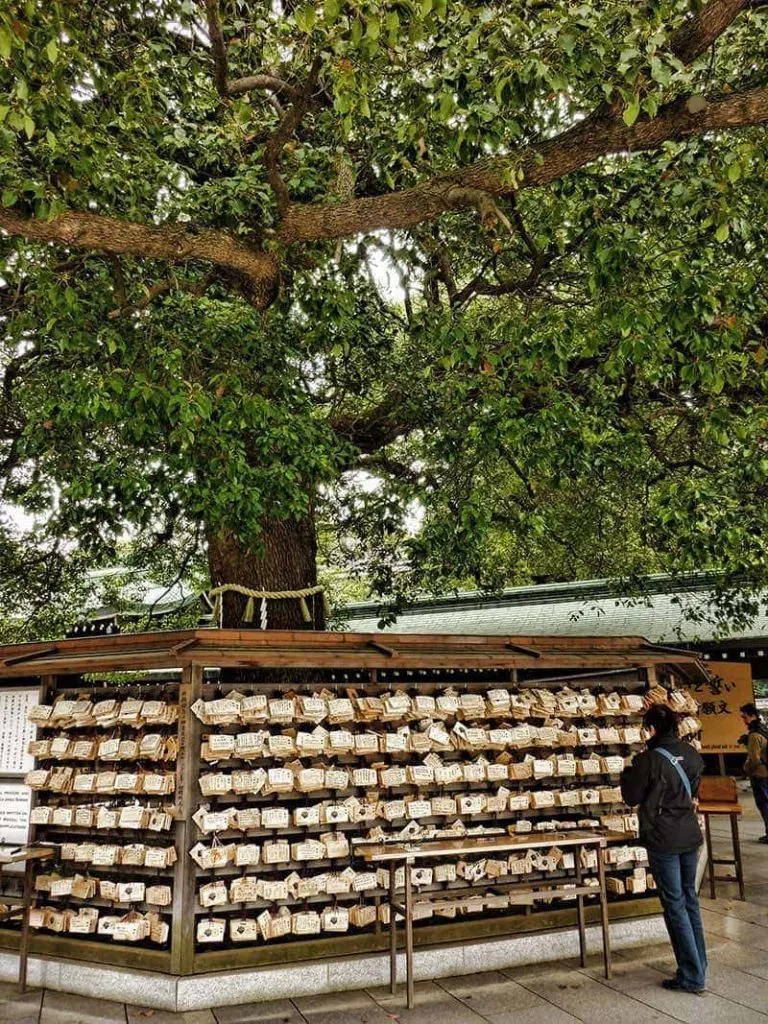
Meiji Shrine is the centre of Shinto celebration in Tokyo, in addition to weddings there are plenty of festivals and celebrations held here throughout the year, we’ve not timed it right so far but top of my list would be to experience:
- Setsubun, (3 February) the change of season from winter to spring
- Shichi-go-san no hi (15 November) 3,5,7 year olds in their kimonos
- Seijiin-no-hi (2nd Monday in January) coming of age day for 20-year-olds in beautiful traditional dress
Getting to Meiji Shrine
The easiest way to get to Meiji Shrine is to take the Subway to Harajuku station, the entrance to the shrine is just behind the exit.
The visit is easily combined with some shopping, eating and people-watching in Harajuku. Just down the road from there is Omotosando home to all the big-name designer stores. Alternatively, Yoyogi park is just down the road from the Shrine and worth a wander round particularly during cherry blossom or on a Sunday afternoon and the Harajuku overpass is generally good for spotting a few of Tokyo’s own Lolitta’s or goths.
Alternatively, hop the subway to your next destination or wander through the neighbouring ward of Shibuya for shopping, entertainment and what must surely be the busiest crossing in the world.
I wouldn’t normally describe myself as a city person but I loved every moment in Tokyo. Please let me know in the comments below the highlights of your trip to the city or if you’re planning to travel in the future would you make time to visit Meiji Shrine?
Chanel | Cultural Xplorer
Friday 24th of July 2015
During my recent trip to Japan, I also enjoyed visiting the Meiji shrine in Tokyo :D
Peter Parkorr
Tuesday 5th of May 2015
I went to plenty of shrines in Japan but I didn't see any as big as that first one - huge!! I did love Tokyo but my favourite city was Kyoto - it was smaller and much easier to see on foot, without any of the feel of a bustling city, and history everywhere. Just incredible! :)
twoaussietravellers@yahoo.com
Tuesday 5th of May 2015
Thanks Peter. I love Kyoto too, actually I love everywhere we've seen in Japan so far. Heian Shrine in Kyoto is pretty huge too and I love their gardens during sakura but there's something about Meiji's city forest that makes it really special.
Herumtreiberin
Monday 4th of May 2015
I really like the pictures you took! You seem to have a good eye for nice photos. :)
Dave Briggs
Monday 4th of May 2015
You aren't the only one that takes photo's of the boards to prompt your memory later! Looks a wonderful place to visit.
Karina
Sunday 3rd of May 2015
This article was brilliant. I enjoyed the information you provided regarding the cultural significance of the Torii gate. Fascinating stuff. How did you do your research? Was the information easily accessible near the Meiji Shrine? The google map you provided was a helpful touch. Thank you for that. Happy trails.
twoaussietravellers@yahoo.com
Sunday 3rd of May 2015
Thanks Karina. I do most of my research either before I visit or at the time. I read all the boards and I photograph them to help my memory later with dates and things, I'm sure everyone thinks I'm mad! In Japan often people want to talk to you to 'practice their English' which is often very good so I always ask them about the place we are at or somewhere else they recommend we visit. I also make friends with the concierge desk, after asking them info once of twice about what we're going to do that day I find they often wave me over and want to help with info for our next plans so I get background info from that or show them a photo I took that day and see if they can fill in the gaps. The Meiji Shrine trees seems common knowledge in Tokyo, maybe in Japan, maybe it's been embellished I don't know. When it was built 100 years ago they had a 150 year plan of what they wanted the end result to look like, how many countries governments or committees even now could boast planning an undertaking with a vision of how that will look 5 generations or more into the future.